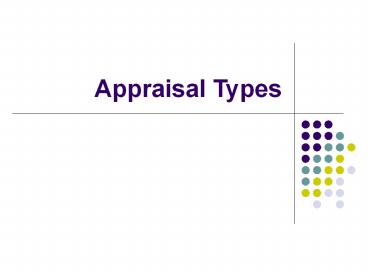Appraisal Types - PowerPoint PPT Presentation
Title:
Appraisal Types
Description:
appraisal types appraisal methods narratives essays critical incidents ranking comparisons alternation paired comparisons checklists simple weighted ... – PowerPoint PPT presentation
Number of Views:285
Avg rating:3.0/5.0
Title: Appraisal Types
1
Appraisal Types
2
APPRAISAL METHODS
- NARRATIVES
- ESSAYS CRITICAL INCIDENTS
- RANKING COMPARISONS
- ALTERNATION PAIRED COMPARISONS
- CHECKLISTS
- SIMPLE WEIGHTED
- RATING SCALES
- GRAPHIC RATING SCALES BEHAVIORALLY ANCHORED
RATING SCALES (BARS) BEHAVIORAL OBSERVATION
SCALES (BOS) - OBJECTIVE MEASURES
- NATURAL COUNTS (Quantity produced, etc)
GOALSETTING STANDARDS (MBO, etc)
3
Performance appraisal attempts to
- Give feedback to improve subsequent performance
- Identify training needs
- Document criteria used to allocate rewards
- Form a basis for personnel decisions
- Provide the opportunity for development
- Facilitate communication
- Validate selection techniques and human resource
policies to meet federal EEO requirements.
4
Appraisal Formats
- Many different formats and procedures have been
tried to meet these multiple objectives. - There are relatively few special rules or special
principles applicable only to the specific
purposes. - There are common formats.
5
Issues with standard practice
- Despite its standard practice in most public and
private organizations for more than 50 years,
performance appraisal still has many problems. - Raters show resistance to criticizing
subordinates, and the judgmental aspect of
evaluating human performance is subject to both
covert (subjective and individual) and overt
(prejudice and bias) errors. - Another consideration is that federal
legislation, court decisions, and guidelines of
several federal agencies have targeted
performance appraisal as a validation procedure
for employee selection techniques and preventing
discrimination in the workplace. The courts have
found organizations in violation of civil rights
laws in failing to validate performance appraisal
criteria and methods.
6
Performance Appraisal Methods
- Performance appraisals take many forms.
- Written essays, the simplest essay method, is a
written narrative assessing an employee's
strengths, weaknesses, past performance,
potential, and provides recommendations for
improvement. - Types of performance appraisal methods include
comparative standards (such as, simple ranking,
paired comparison, forced distribution) and
absolute standards (such as, critical incidents,
BARS, MBO).
7
Comparative Standards or Multi-person Comparison
- This relative, as opposed to absolute method,
compares one employee's performance with that of
one or more others. - In group rank ordering the supervisor places
employees into a particular classification such
as "top one-fifth" and "second one-fifth". If a
supervisor has ten employees, only two could be
in the top fifth, and two must be assigned to the
bottom fifth. - In individual ranking the supervisor lists
employees from highest to lowest. The difference
between the top two employees is assumed
equivalent to the difference between the bottom
two employees. - In paired comparison the supervisor compares each
employee with every other employee in the group
and rates each as either superior or weaker of
the pair. After all comparisons are made, each
employee is assigned a summary or ranking based
on the number of superior scores received.
8
Formats
- Critical Incidents. The supervisor's attention is
focused on specific or critical behaviors that
separate effective from ineffective performance. - Graphic Rating Scale. This method lists a set of
performance factors such as job knowledge, work
quality, cooperation that the supervisor uses to
rate employee performance using an incremental
scale. - Behaviorally Anchored Rating Scales (BARS). BARS
combine elements from critical incident and
graphic rating scale approaches. The supervisor
rates employees according to items on a numerical
scale.
9
Formats
- Management by Objectives. MBO evaluates how well
an employee has accomplished objectives
determined to be critical in job performance. - This method aligns objectives with quantitative
measures such as sales, profits, zero-defect
units produced. - 360 Degree Feedback. This multi-source feedback
method provides a comprehensive perspective of
employee performance by utilizing feedback from
the full circle of people with whom the employee
interacts supervisors, subordinates and
co-workers. It is effective for career coaching
and identifying strengths and weaknesses. See 360
Degree examples http//www.bmpcoe.org/bestpractice
s/external/mash/mash_18.html and
http//www.bmpcoe.org/bestpractices/external/ccad/
ccad_23.html
10
Which format?
- Which one works?
- What have you seen in action?
- Is it the format or the underlying concept that
is problematic?
11
SUMMARY GUIDELINES FOR APPRAISALS
- Appraisal standards are job related
- Standards are clearly communicated to employees
in advance - Standards are responsive to actual worker
behavior or effort - Activities performed and results achieved are
both appraised - Acceptable vs. unacceptable results can clearly
be discerned - Appraisal criteria are consistently applied
- Raters are able to consistently observe work
performance - Raters are trained in appraisal and how to
feedback results - Developmental feedback is separated from
judgmental appraisal - An appeal process exists to resolve (judgmental)
rating disputes































